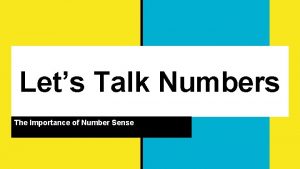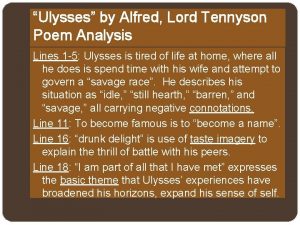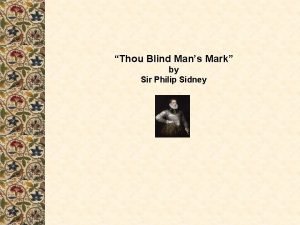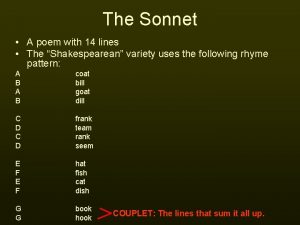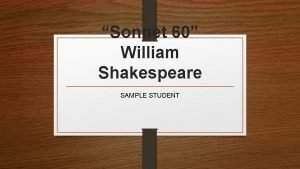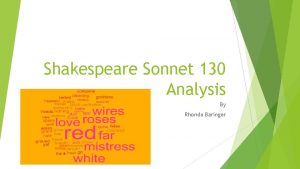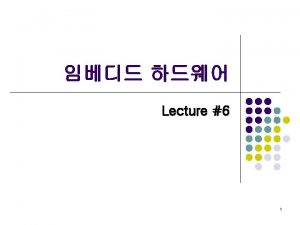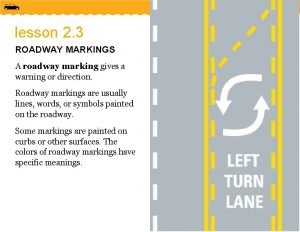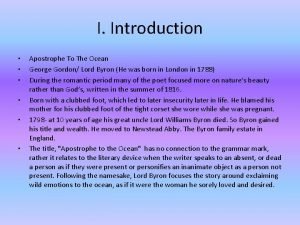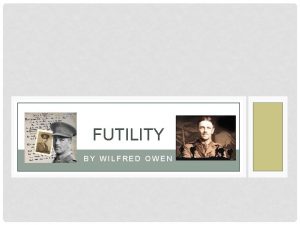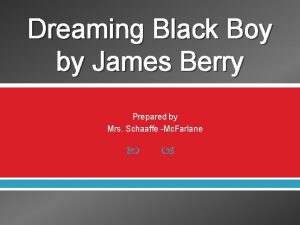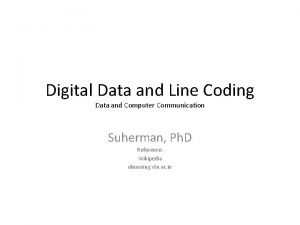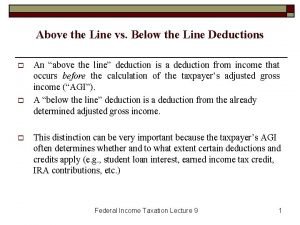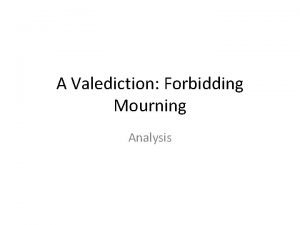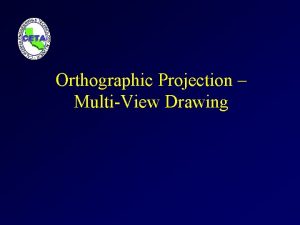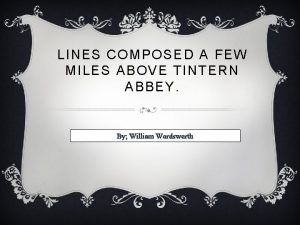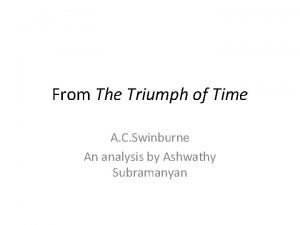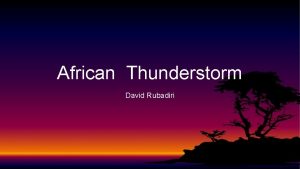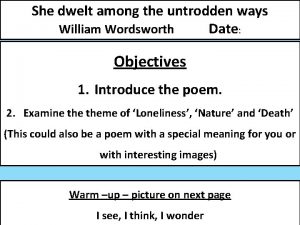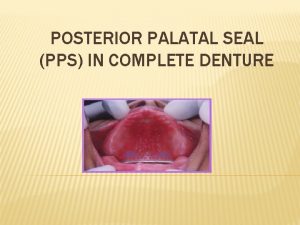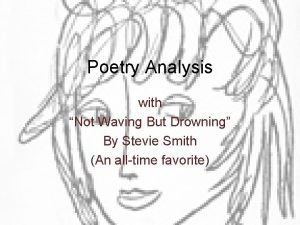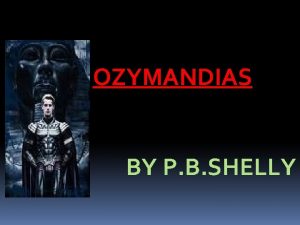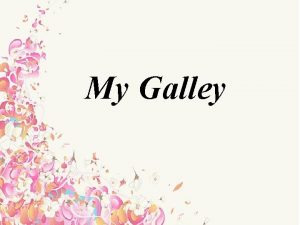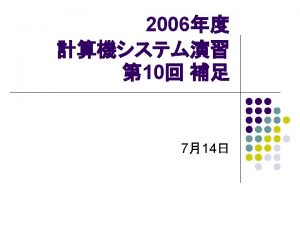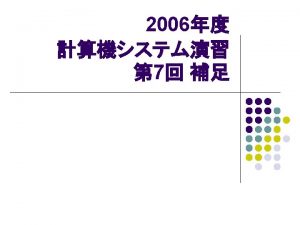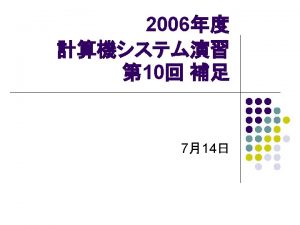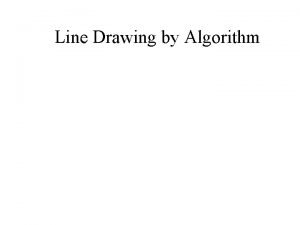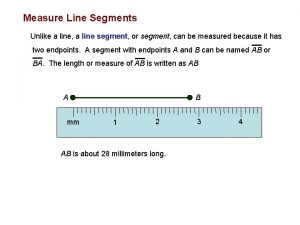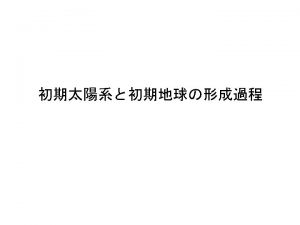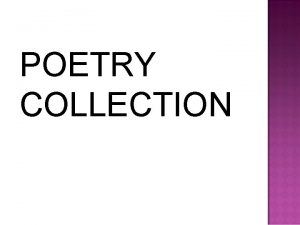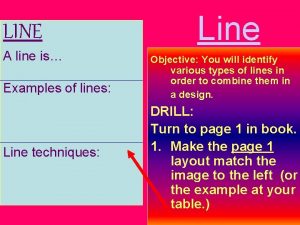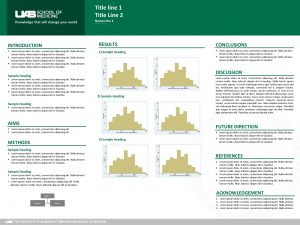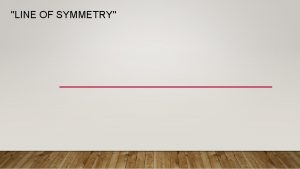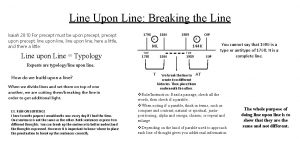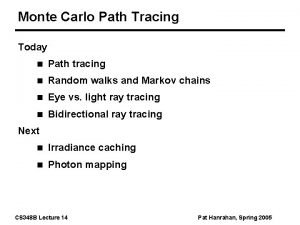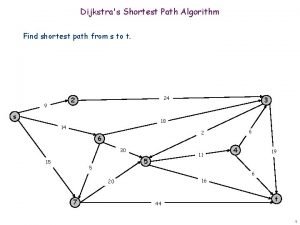Line A line is a path that a






















































- Slides: 54

Line A line is a path that a point takes through space. Lines can be thick, thin, dotted or solid. They can make straight movements, zig-zags, waves or curls. They may be horizontal vertical diagonal 1

Hatching Create a 7 point value scale in your notes 2

Shape 9/15 l Shape To an artist, a shape is an area clearly set off by one or more of the other five elements of art. l Geometric—precise, mathematical shapes made with a special tool. l Organic or Free-form—not regular or even, such as those found in nature. 3

Hue l The color’s name l Primary Colors (first or pure colors) l l Red, yellow, and blue All colors are made from these Secondary or intermediate colors l Created by mixing two primary colors 4

Secondary Colors l Colors created by mixing 2 primary colors l l l Red and blue = purple Blue and yellow= green Red and yellow= orange 5

Intermediate Colors l Also called tertiary colors Mixing a primary color, like red, with a secondary color, like orange, produces an intermediate color, like red-orange. Primary + Secondary = Intermediate Examples Blue + purple = indigo or blue violet Red + purple = red violet Yellow + green = chartreuse or yellow-green l 6

Intensity l The brightness or dullness of a hue. l A strong, bright hue is said to be “high intensity. ” l l Example--pure green A faint, dull tone is said to be “low intensity. ” l l Olive green is a hue that fits this description. Lowering the intensity of a color can be done by mixing it with its complement. 7

Value l 9/11 The lightness or darkness of a color You can change a color’s value in two ways. 1. add white or black a. add white to create a tint b. add black to create shade 2. add the color’s complementary color i. e. blue to orange, red to green 8

Clean up l l Clean out water, brush and palette Fill water Place everything back on your table ready for the next class. Take or toss your work. 9

Analogous Colors 9/29 Some Formulas for Color Harmony There are many theories for harmony. The following illustrations and descriptions present some basic formulae. A color scheme based on analogous colors Analogous colors are any three colors which are side by side on a 12 part color wheel, such as yellow-green, yellow, and yellow-orange. Usually one of the three colors predominates. 10

Complementary Colors l A color scheme based on complementary colors l Complementary colors are any two colors which are directly opposite each other, such as red and green and red-purple and yellow-green. In the illustration above, there are several variations of yellow-green in the leaves and several variations of red-purple in the orchid. These opposing colors create maximum contrast and maximum stability. 11

Triad l Three colors evenly spaced on the color wheel. l Examples l l Red, yellow, blue Orange, green, and purple 12

Color Spectrum l A band of colors produced when white light shines through a prism. 13

Changing Values with Complementary Colors l l l Intensity, also called chroma or saturation, refers to the brightness of a color. You can change the intensity of a color by adding its complement (this is the color found directly opposite on the traditional color wheel). When changing colors this way, the color produced is called a tone. When you mix complementary colors together, you produce a dull tone. 14

Monochromatic l A color scheme made up of only a single color or hue and its tints and shades. l Neutrals l Black, brown, gray, or white 15

Space l Space is the distance or area between, around, above, below, and withings. l Space is empty until shapes or forms fill it. l Real § l Sculpture Suggested § Painting 16

Space Techniques in 2 Dimensional Art l Linear perspective l Size l Overlapping l Placement 17

Linear Perspective Linear perspective is a mathematical system for creating the illusion of space and distance on a flat surface. 1. A. B. The system originated in Florence, Italy in the early 1400 s. Three components are the horizon line, the vanishing point (s), and the orthogonal lines leading to the vanishing points. 18

Texture l l An element of art which refers to the surface quality or "feel" of an object, its smoothness, roughness, softness, etc. Textures may be actual or simulated. Actual textures can be felt with the fingers, while simulated textures are suggested by the way the artist has painted certain areas of a picture. In art, texture is how things feel, or look as though they might feel, if touched. l Can be tactile (can be touched) l Can be visual 19

Linear Perspective B. The vanishing point should be located near the center of the horizon line. The vanishing point is where all lines (orthogonals) that run towards the horizon line appear to come together like train tracks in the distance. 20

Linear Perspective A. The horizon line runs across the canvas at the eye level of the viewer. The horizon line is where the sky appears to meet the ground. 21

Linear Perspective C. Orthogonal lines are "visual rays" helping the viewer's eye to connect points around the edges of the canvas to the vanishing point. An artist uses them to align the edges of walls and paving stones. 22

One Point Perspective 23

Two Point Perspective l l l Perspective is a technique for representing threedimensional space on a flat surface. To create this illusion of space, the artist establishes one or two vanishing points on the horizon line. Objects are drawn using orthogonal lines which lead to the vanishing point(s). Objects seen at an angle would be drawn with twopoint perspective using two vanishing points. 24

Form l Form is an element of art that refers to an object with three dimensions. l l Experience the art in its height, width, and depth. Forms are classified as geometric and organic. 25

Balance l The principle of art concerned with arranging the elements so that no one part of the work overpowers, or seems heavier than, any other part. l l l Formal balance Informal balance Radial balance. 26

Formal Balance In formal balance, the work can visually be divided in half. l No one side dominates the pictures. l Formal Balance pictures will have an imaginary "line of symmetry. ” l Does NOT have to illustrate an exact mirror image. l 27

Informal Balance These are examples of Informal Balance. The large form of the woman is "visually equal" to the black curtain and white painting on the wall. l Informal balance makes the painting appear balanced, though the composition is more relaxed and less stiff. l In the second picture, the larger figures to the right are balanced by the many smaller figures to the left. l 28

Radial Balance 11/4 These are examples of Radial Balance. Look for a spiral or spinning effect of the pattern. The axis is the center point and the design or pattern appears to "radiate" from that point. l 29

Contrast l l Contrast in art and design occurs when two related elements are different. The greater the difference the greater the contrast. Contrast adds variety to the total design and creates unity. It is what draws the viewer's eye into the painting and helps to guide the viewer around the art piece. 30

Contrast Francisco Goya “The Third of May 31

The Principle of Movement l l 11/5 The principle in art that leads the viewer to sense action in a work, or It can be the path the viewer’s eye follows through the work. 32

The Principles of Pattern and Rhythm l In art, rhythm is the repetition of an element of art to make a work seem active. 33

Renaissance l l A period in European history extending roughly from the 1300’s to the 1600’s. Renaissance means “rebirth. ” l l Characterized by a rebirth of interest in the ancient world. This was a period marked by great scientific and artistic achievements, especially in Italy. 34

Raphael “School of Athens” 35

Variety l Combining one or more elements of art (line, color, form, shape, space, texture, value) to create interest. l l Splash of color will add zest to a painting that has mostly dull tones. A free form shape added to mostly geometric images. 36

Proportion refers to one piece of an object in relation to the rest of the object. 37

The Principle of Unity l 11/7 The arrangement of elements and principles of art to create a feeling of completeness or wholeness. 38

Joseph Turner “Valley of Aosta: Snowstorm, Avalanche, and Thunderstom. ” l l Proportion to contrast the vast fury of the storm with the small people, vivid movement with line and color, adds excitement and suspense through informal balance. Draws the viewer’s eye from one part of the work to another throuhg variety in shape, form, and color. 39

Perception l 11/7 An awareness of the elements of an environment by means of the senses. l l More than looking at an object. Really seeing the object. l Observe how shapes, forms, lines, and colors blend to form the whole. 40

l Emphasis is making an element or an object stand out. l May be done through l l l contrasting colors to draw the viewer’s eye to one area shape and proportion any other element of art. 41

Shading Techniques l l Hatching—Drawing thin lines all running in the same direction. Crosshatching—This is drawing crisscrossing lines. Blending—changing color value little by little. Stippling—creating dark values by means of a dot pattern. 42

l 43

Art Criticism 11/19 l l 1. Describing What do I see? 2. Analyzing How is the work of art organized according to the elements of art and design principles? 3. Interpreting What is the artist saying to me? 4. Judging Is the work successful? 44

Collage l l From the French word meaning “to glue. ” An artwork arranged from cut or torn materials that are pasted to a surface. l You will need by Tuesday: l l Support--canvas (best), foam board Found items to place on collage Discarded magazines A theme 45

Collage Name the elements you are using in your piece --Line, color, form, shape, space, texture, value. Which design principles will you create in this work? Balance Emphasis Contrast Movement Pattern Rhythm Unity 46

Balance in Composition l Visual interest is what you balance in design. Different colors, shapes sizes, etc. create different degrees of interest. Subject matter changes the situation because different objects can call more (or less) attention to themselves because of their content and relationships to other objects in the image. 47

Romare Bearden 1. What is collage? What kinds of materials can be used in creating a collage? 2 What was the civil rights movement of the 1960’s How did it influence Romare Bearden’s art 3 What expressive techniques does Bearden use in his collages? 4 What is happening in Prevalence for Ritual: Baptism? Why was this event significant to Bearden? 48

Surface Enriching Media in Collage 11/21 l l l Watercolor, gouache, tempera, and acrylics Inks, dyes Silkscreening, block printing, pen and ink, pens Graphite pencils, charcoal, crayon, or pastels Colored pencils, watercolor pencils or sticks, colored markers Metallic paints or markers 49

Name_____________ Period # Evaluating Your Tree House l Look at your tree house. l Which principles of Check at least 4 design have you elements of art you achieved in your work? used in creating it. (Use at least 4) l l l l Line Color Form Shape Space Texture Value l l l l Balance Contrast Emphasis Movement Pattern Rhythm Unity 50

Tree house Evaluation l Look at your treehouse. Check at least 4 elements of art you used in creating it. l l l l Line Color Form Shape Space Texture Value l Which principles of design have you achieved in your work? (Use at least 3/more is better for variety) l Balance l Contrast l Emphasis l Movement l Pattern l Rhythm l Unity 51

Final Project l l l Final Design Project You will be creating a final design project due next Friday. You will design a new phone cover. This should be a new design, something no one has seen before, and your phone cover should include four of the elements (line, space, shape, form, value, color) and at least two principles (contrast, rhythm, movement, pattern, variety, and emphasis) 52

Evaluating Your Art Elements and Design Principles l l l l Which principles of design have you achieved in your work? Through which elements? Balance __________ Contrast __________ Emphasis __________ Movement __________ Pattern __________ Rhythm __________ Unity __________ 53

One Point Perspective l l l l l Create templates for lettering Cut out letters Create a horizon line and vanishing point on large white paper Trace letters onto large white sheet of paper Connect corners to vanishing point Color with colored pencils to make name pop with color, pattern, line, shape, etc. Cut out final product and back onto black paper Write name and period # on back Turn into tray 54
 Ngoại tâm thu thất chùm đôi
Ngoại tâm thu thất chùm đôi Block nhĩ thất độ 2 mobitz 2
Block nhĩ thất độ 2 mobitz 2 Thơ thất ngôn tứ tuyệt đường luật
Thơ thất ngôn tứ tuyệt đường luật Thơ thất ngôn tứ tuyệt đường luật
Thơ thất ngôn tứ tuyệt đường luật Chiến lược kinh doanh quốc tế của walmart
Chiến lược kinh doanh quốc tế của walmart Tìm vết của mặt phẳng
Tìm vết của mặt phẳng Con hãy đưa tay khi thấy người vấp ngã
Con hãy đưa tay khi thấy người vấp ngã Tôn thất thuyết là ai
Tôn thất thuyết là ai Gây tê cơ vuông thắt lưng
Gây tê cơ vuông thắt lưng Sau thất bại ở hồ điển triệt
Sau thất bại ở hồ điển triệt Unity signalr
Unity signalr Representative fraction
Representative fraction The path of a moving point in art
The path of a moving point in art Examples of number sense
Examples of number sense Ulysses poem explanation
Ulysses poem explanation To daffodils by robert herrick summary
To daffodils by robert herrick summary Poetic devices in thou blind man's mark
Poetic devices in thou blind man's mark A poem of 14 lines
A poem of 14 lines Tajmahal poem by rabindranath tagore
Tajmahal poem by rabindranath tagore Shakespeare sonnet 60 analysis
Shakespeare sonnet 60 analysis Sonnet rhyme scheme
Sonnet rhyme scheme Being your slave what should i do but tend analysis
Being your slave what should i do but tend analysis Shakespeare 130 sonnet analysis
Shakespeare 130 sonnet analysis Word line bit line
Word line bit line Prologue in romeo and juliet
Prologue in romeo and juliet Farewell love sir thomas wyatt
Farewell love sir thomas wyatt Thunderstorm at 4 am poem
Thunderstorm at 4 am poem Burning a book poem
Burning a book poem Is nothing gold can stay a metaphor
Is nothing gold can stay a metaphor The poem money madness
The poem money madness What to do when you see red raised roadway markers
What to do when you see red raised roadway markers Figurative language in apostrophe to the ocean
Figurative language in apostrophe to the ocean In vain thou madest me to vain things aspire
In vain thou madest me to vain things aspire Futility poem analysis line by line
Futility poem analysis line by line Out out robert frost summary
Out out robert frost summary Dreaming black boy poem questions and answers
Dreaming black boy poem questions and answers Line by line coding
Line by line coding Count that day lost explanation
Count that day lost explanation Above the line vs below the line
Above the line vs below the line Valediction calamity
Valediction calamity One's self i sing meaning
One's self i sing meaning Miterline
Miterline Of simulation and dissimulation by francis bacon pdf
Of simulation and dissimulation by francis bacon pdf Tintern abbey analysis line by line
Tintern abbey analysis line by line The triumph of time swinburne
The triumph of time swinburne An african thunderstorm summary
An african thunderstorm summary Nicene creed holy trinity
Nicene creed holy trinity Rime of the ancient mariner rhyme scheme
Rime of the ancient mariner rhyme scheme Wordsworth she dwelt among the untrodden ways analysis
Wordsworth she dwelt among the untrodden ways analysis Palatal fovea
Palatal fovea Not waving but drowning analysis
Not waving but drowning analysis How to construct a parallel line
How to construct a parallel line Ozymandias explanation with quotations
Ozymandias explanation with quotations Rhyming scheme of o captain my captain
Rhyming scheme of o captain my captain My galley charged with forgetfulness line by line analysis
My galley charged with forgetfulness line by line analysis













